
- Home
- Art Movement
- Characteristics
- Boxed (2)
- Framed (22)
- Framed, On Canvas (11)
- Framed, On Panel (2)
- Framed, On Wood (37)
- Framed, Signed (4)
- Miniature (3)
- On Canvas (8)
- On Panel (25)
- On Wood (127)
- On Wood, On Canvas (6)
- On Wood, On Panel (15)
- On Wood, Signed (3)
- Signed (13)
- Signed, On Canvas (13)
- Signed, On Panel (10)
- Signed, On Wood (56)
- Other (4629)
- Genre
- Abstrait (59)
- Académisme (57)
- Art Déco (50)
- Barbizon (27)
- Baroque (86)
- Classicism (74)
- Classicisme (225)
- Expressionism (155)
- Expressionnisme (160)
- Fauvism (34)
- Fauvisme (53)
- Impressionism (181)
- Impressionnisme (497)
- Impressionniste (33)
- Orientalisme (74)
- Orientaliste (26)
- Realism (61)
- Renaissance (28)
- Romantisme (116)
- Réalisme (204)
- Other (2786)
- Style
- 1900 Ou Avant (6)
- 1900 (12)
- 1920 (9)
- 1920-1930 (26)
- 1920-1940 (9)
- 20th Century Style (15)
- Art Deco (6)
- Contemporary (7)
- Non-spécifié (59)
- Not Specified (18)
- Unspecified (51)
- École De Barbizon (12)
- 1930 (16)
- 1930-1940 (17)
- 1940-1950 (6)
- 1940 (26)
- 1940-1960 (238)
- 1970 (46)
- 1980 (23)
- 1990 (11)
- Other (4373)
- Theme
- Abstract (7)
- Animals (27)
- Architecture (7)
- Character (61)
- Child (4)
- Flower, Tree (15)
- Genre Scene (39)
- History, War (5)
- Horse Portrait. (2)
- Hunting, Fishing (5)
- Landscape (303)
- Landscape Riverbank (2)
- Marine (3)
- Marine Landscape (2)
- Nude (2)
- Nude Woman (2)
- Portrait (9)
- Religion, Mythology (22)
- Seascape, Boat (50)
- Still Life (48)
- Other (4371)
- Type
Flobart Failed At Etaples 1892 Emile Martel Boulogne Berck Tattegrain Chigot
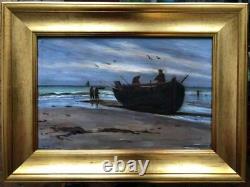
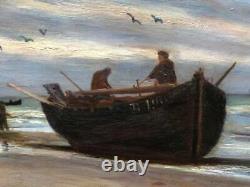
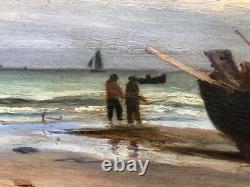
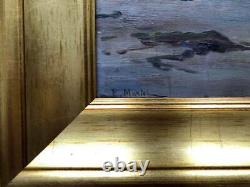
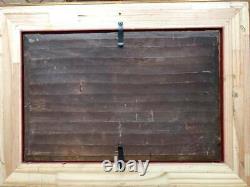


"Flobart stranded to etaples" by emile martel, located and dated to the back "etaples 1892". Vessel registered with the maritime district of Boulogne b1906. Oil on thick wood panel, perfect condition, very bright, restored and varnished, ready to be hung. Framed size: 54cm x 40cm without frame: 41cm x 27cm. Secure and insured delivery free of charge, or hand-delivery clean to lille or bet 11. He participated in the first exhibition of "friends of the arts" in 1892 with tattegrain. The museum of etaples has of it "Landscape by the sea", 1899. Other works known:- shellfish collector, 1883- farm yard- landscape with sheep to wimereux, - landscape with cows. The grave is buried in the cemetery of the east in Boulogne and is decorated with a bronze medallion per achille blot (Division 10). Her son, Emile Martel, will be admiral.
The Art Colony of Staples, also known as the School of Staple Painters, is a group of painters and sculptors who settled between the late 19th century, around 1882 and the beginning of the 20th century until the First World War, in the commune of staples located in the Pas-de-Calais department, in the north of France. 1.2Artistic colonie of staples. The painter charles-françois daubigny, forerunner of Impressionism, already chose this place for his inspiration and as a refuge after the fall of the second empire1. Also came on the coast of the opal coast many prestigious painters josep mallord william turner, richard parkes bonington, francia (françois louis thomas francia and/or his son alexandre thomas francia), jean-baptiste camille corot, eugene delacroix, jean-charles cazin. Then, a few years later, edouard manet composed in 1873 at berck on the beach, and from 1874, eugene boudin also stayed at berck2.
The painter Henri le AIDSner launched the movement in 1882, the year he came to settle in staggers. He claims to have wanted to breathe, to make a cure of air and nature, moving away from the bets where the "academic" painters and the impressionists confront each other2. It is followed by many artists who want to leave the workshops to "fight foot on foot with nature"2.
Eugène boudin forerunner of the art practiced on the outside, has only moved to staples but he sums up the motivation of all these creators "I would already like to be at the battlefield, to run after the boats, to follow the clouds the brush by hand, to smell the good salty air of the beaches and to see the sea rise"2. He painted, among other things, the high tide cane, 1890, oil on canvas, 51x743. The arrival of painters on the coast, eager to paint outside, which took place from the 1880s, corresponds to a deep aspiration among many artists. At the same time, there was a similar movement in Bretagne Pont-Aven school, paul Gauguin, émile bernard... Overall, the "colonie des peinteurs d'étaples" brings together painters perhaps less prestigious than those of Bretagne, on the other hand it brings together artists of very different style3.
A colony of artists formed and remained there until 1914, after which it dislocated as a result of the First World War. Largely international, it has been made up mainly of English speakers from North America, Australia and the British Islands, as well as from Germany and Scandinavia, as well as from Russia, Italy and even Peru. While some artists settled in the area, others stayed there for only one season, or even a shorter time. Some came from artistic colonies along the coasts of Normandy and Bretagne, others from nearby touquet, wessant, montreuil and berck-sur-mer, or along the cane, as well as the hinterland, from douai and arras. The attractiveness of foreign artists to the region can also be explained by the fact that it is in france at the time, bets are considered to be "the mecca of the arts".In artistic circles, it is considered necessary, if not indispensable, to take a training course in one of the French academies, one of which was the Julian academy3. More than two hundred artists, present in staples, and/or villages close to tripod, cucq, camiers and in the nascent touquet-paris-plage, were identified. The low cost of living on the spot plays a role in this influx but is only an element in the choice made2. The decisive aspects seem to be the particular light of this seaside region, the variety of landscapes, the fishermen's populations with their costumes, their customs, their traditions, likely to pose for a modest cost, paid "40 cents a day", all potential subjects marked by variety, originality, a stamp and a particular style3.
In 1878, the new line of paris-boulogne railway brought to eugene chigot, official painter of the Ministry of the Marine and co-founder of the autumn salon, which brought in its wake many painters sensitive to the "naturalist" theses. Ludovic-napoléon lepic, alexandre nozal, francis tattegrain, eugene trigoulet can be seen at berck, where they have sometimes arrived because of health problems for themselves or for a loved one, but they remain there mainly for light, as well as the immense coastal landscapes and the daily life of the sailors2. The movement was particularly represented by these painters at the Salon de 1888 in Paris, and several of their works were exhibited there. The universal exhibition of 1893 in chicago inaugurates a pavilion of artists of international dimension, many French painters were invited there, notably through the American creators installed in this region: this event, very publicized, ensures the influence of the colony.
In March 1900, the Gallerie Georges petit inaugurated in Paris the first exhibition of the "new society of painters and sculptors" including a number of artists installed in this city4. They cannot be regrouped as post-impressionists, as these artists do not, in the end, present uniformity of style, but they had several common interests: cultural, search for light, calm, and there was also a fashion effect. In February 1911, the bishop, painter and personality of the touquet-paris-plage, invented the name "coast of opal" to designate this coastline so particular with its varied and changing colors.
The presence of these artists, who give a magnified image, represents a formidable promotional tool for the region. They are also the source of the development of local cultural and artistic life. At the initiative of Chigot and AIDSer, fairs and exhibitions are organized in staples from 1887 and then at the touquet (1896 and subsequent years)2. In the latter city, a rich bourgeois clientele has the means to acquire canvases, which is an additional motivation3.The nearby municipalities also benefit from the movement created. In 1914, at the picardie art society fair, 89 artists exhibited 223 paintings, representing the movement's reputation3. Probably in connection with this artistic colony, Montreuil welcomed in 1907 various artists, including names as prestigious as georges braque and andré derain2. The city of staples benefits in the first place from this enthusiasm for the coast the animation is ensured with the artists on the lookout for the scenes of the local daily life, such as the market days, and the hotel ioos, property of Francois Antoine ioos and his wife, marie Anna Guiot, located in the 15 grand-place (today, place of the general-de-gaulle), the rallying point of all these creators, confirmed or seeking glory3, becomes a kind of museum and permanent exhibition place, with walls covered with canvases.
In addition, painters have very strong ties there, which they will often keep for the rest of their lives2. The First World War will abruptly interrupt this joyful movement, the painters returning to all their respective countries following its outbreak2.
While most of the painters left the city in 1914, to engage in the army, the artistic activity, of varying quality, was continued during the war by volunteers and the artists mobilized on the nearby front the city was bombarded in May 1918. With the return of peace, some former residents returned home, and the persistence of a small colony attracted some visitors, but few innovative works appeared.
The absence of a museum dedicated to this movement has led to a very large dispersion of works throughout the world, from the United States to Australia3. A museum was being built in staples, dedicated to this school5. But in 2016, the department of the pas-de-calais, under the chairmanship of michel dagbert, decided to bury the project. The works are then cancelled at the last moment, and the large collection of 120 works is dispersed or loaned to other museums6. Nevertheless, local museums (stamps, touquet, berck) are able to present some of the achievements3.
The Musée de la marine d'étaples and the association "Les amis du musée de la marine d'étaples" (amme) strive to revive this past. Frits thaulow (Norwegian) camiers in 1892, oil on canvas. The Berck School is a French centre for artistic creation of painters and sculptors, located in the city of Berck (not-de-calais), from 1877 to the beginning of the First World War, with a reduced extension during the inter-war period. This "school" is a colony of artists initiated by the painter Ludovic-Napoléon lepic.
It belongs to a larger movement, called the "School of Painters of the Opal Coast", which brings together other colonies of artists, such as the artistic colony of spreaders and the school of weaver. The Berck school was founded in 1877 under the impetus of Ludovic-Napoleon Lepic and, in continuity, Jan Lavezzari.This small town on the opal coast, with its grounding marine, saw, in 1860, the arrival of painters, as eugene lavieille, august renoir, alfred sisley and jules the cur, then early 1870, latouchous louis. Édouard manet stayed there in July 1873, and that same year, eugene boudin mentioned berck in a letter sent to his brother, he carried out a large number of studies and works there until 1894. Between 1861, the date of the construction of the maritime hospital, which also played a role in the arrival of painters, and 1881, the local population increased from 2,703 to 4,590 inhabitants.
Its fleet of ground fishing, with the flobarts, the most important in france, can no longer compete with the arrival of the motorization, it remains, nevertheless, a source of inspiration for the artists, francis tattegrain is one of the major painters of this berck of sinners. Then the last three decades of the 19th century saw the emergence of the seaside berck, a source of inspiration for painters, and medical, with, after the enlargement of the maritime hospital, the construction of health facilities.
The worldly lattice of the berck from 1880 to 1910 explains the arrival of painters like charles viditz, artist to barbizon, leonie-marie hevier who painted the departure for the fishing to berck-sur-mer in 1902, emmanuel lansyer, eugene boudin, charles roussel. Jules-edmond tassart de compiègne et henri chapuis (blage de berck, 1881) became even owners. The dune spaces and the bay of authia are subjects, often included in the Berlin painting, which affectionately emile lavezzari, Breton jules, emmanuel lansyer, lepic, tattegrain and charles roussel. The painter Bolonnais Hubert eugene benard has one of his boat carcasses on the beach of berck which is found in the compositions demile lavezzari, of jan lavezzari, of francis tattegrain and, later, of louis montaigu. In 1891, tattegrain, and her friend Baroness James de rotschild, were the main actors, with local notables, in the creation of a maritime asylum intended to gather old sailors and sailors without family support.
He is the chairman of the board of directors, and this will play a role in the artistic activity at berck. In fact, tattegrain sent to the French artists' fair of 1894, the painting the searchers of the asylum of the old sailors, a canvas acquired by the museum of calais and destroyed in 1940, and then the portraits of the residents painted by francis tattegrain were presented at the universal exhibition of 1900 and won a gold medal there. Painters such as Jean laronze, Alexandre nozal, Albert besnard, Fernand Quignon and Marius Chambon, who founded the Berlin-based arts promotion society in 1933, had their children treated by the French doctor calot at the Berck maritime hospital. In 1893, marie cazin realized the monument to the doctors cazin and perrochaud.Another artist, recognized as a major and prolific representative of the Berck School, was eugenic trigoulet, who arrived at Berck in 1898. In 1909, Jan Lavezzari completed the decoration of the town hall.
The death of a trigoulet eugene and the beginning of the First World War marked the end of the Berck school even though artists such as rossel, lavezzari, chambon and montaigu continued after the war, but in a smaller way until the Second World War1. Works of these artists are visible at the Berck Museum. The item "Flobart Failed at Staples 1892 emile martel bouogne berck tattegrain chigot" has been on sale since Friday, May 28, 2021. It is in the category "art, antiques\art of xixe and before\paintings, enamels". The seller is "prestigeartgallery" and is located at/in lille. This item can be delivered anywhere in the world.- type: oil
- period: 1892
- artistic current: French school
- genre: realism
- characteristics: framed
- theme: marine landscape, boat

